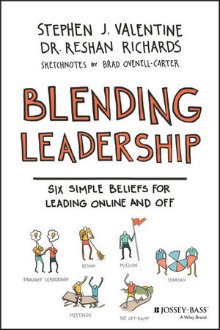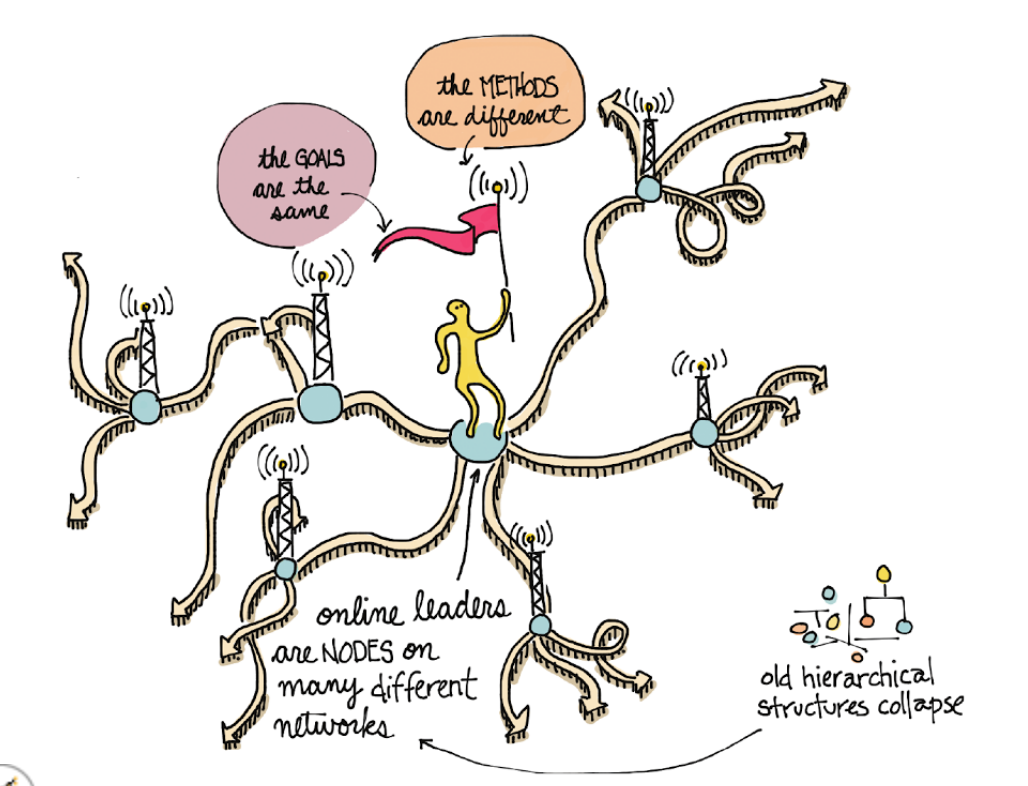Blending Leadership: Leading Online and Off
Blending Leadership: Six Simple Beliefs for Leading Online and Off
By Stephen J. Valentine, Dr. Reshan Richards, and Sketchnotes by Brad Ovenell-Carter
(Jossey-Bass, 2016 – Learn more)

The premise of Blending Leadership is that collaboration is now the norm and leadership is less hierarchical. We need “distributed” leadership, a blending of on-line and face-to-face: “Blended leaders lead the learning and lead by learning.”
Stephen Valentine and Reshan Richards stress the importance of a core set of beliefs to filter new information. They researched, and also paid attention to their own learning.

Belief #1: BLENDED LEADERS ENGAGE WITH THOUGHT LEADERS AND ENGAGE AS THOUGHT LEADERS.
An example is Steve’s planning of a leadership retreat when his building was empty in summer, and how he found a blog by Mark Crotty, head of a school in Texas. Steve wanted to clarify his thinking on the topic of grit. In other words, Steve was open to others’ experiences and willing to learn in places and ways others might not.
An even better example is engaging further, like Reshan does with an online forum. Today’s leaders can’t be insular. We need to go to smart people outside our institutions: “Not all the smart people are within your organization.” Those who do better, the authors contend, are better connected.
They also note that the person who attains new information earlier has an advantage in terms of outstanding evaluations and promotion. One should even talk to others outside the educational field. Learning might be messy but the payoff is arriving at insights not neatly packaged.
Belief #2: BLENDED LEADERS DESIGN SPACES AND CARE FOR SPACES.
If a leader does not give much attention to space and the caring of it, a lot of problems can arise, including inefficiency. An example is given about how Reshan allowed a class to arrange the furniture and classroom space all on their own. The authors discuss reducing clutter even on the computer and in the writing of their book. Learn how to make design thinking a habit, on-line and off.
Belief #3: BLENDED LEADERS REJECT INSULARITY AND EMBRACE SHARING.
Humility can lead to serious innovation. The leader doesn’t have to have all the answers. Growth-minded leaders ask for help. Learn the difference between the “best” and the “right” collaborators, and why e-mail is about knowledge and control. See how to display an #edchat in your Faculty Lounge, or how templates can help.

Belief #4: BLENDED LEADERS CHALLENGE MEETING STRUCTURES AND CHANGE MEETING STRUCTURES.
Read about the difference between managers and makers and why “bad collaboration is worse than no collaboration.” Learn how to avoid “meetingocrity” and how over-planning can blind us to change. The authors propose thinking of meeting time as a circle.
Belief #5: BLENDED LEADERS ARTICULATE A MISSION AND ADVANCE A MISSION.
Read about how to line up everything with the mission of the school and to do it enthusiastically. Learn how available tools, like Twitter, can help you and how different technologies reveal different angles of your mission.
Belief #6: BLENDED LEADERS KEEP THE OFF-RAMP OPEN AND USE IT FREQUENTLY.
Steve and Reshan encourage us to exit the internet superhighway regularly: “If you spend all your time online, you will not lead as well as you could.” Leaders must realize that “tools (like SMART Board) will change; the aspiration driving the use of the tools should not.” We need to stay focused on the learning objective and use the best available tool of the time to support the goal (“wear your habits lightly”).
You’ll also read about the moral component of walking away from the online world from time to time. Psychologist Rex Jung says ‘meandering’ is “an essential aspect of creativity.”
Take-aways
Blended leaders need to build new skills, awareness and habits. The authors warn about too much onlineness, too much connectedness to screens that we lose our sense of empathy (like in Bradbury’s Fahrenheit 451).
All six beliefs are worthy core beliefs for a school and a leader. I worry that most individuals in leadership roles are not as technologically astute as these two authors, one of whom has programming skills and took apart his computer to learn better how it works.
Some of the examples are very technical, and there is the danger of the book becoming quickly dated. I wish union constraints and some other typical leadership constraints – and how to handle them – had been discussed.
Yet there is a great deal to value in this book as leaders work to keep pace with the changes that are occurring. Change with intention is better than haphazard change, and these six beliefs will help to guide new and experienced leaders.
Mary Langer Thompson is a retired school principal and former English teacher. She received her Ed.D. from University of California, Los Angeles and lives in southern California in the high desert with her husband Dave. Because of her school and community work teaching memoir and poetry, she recently was honored as a “Woman of Distinction” by her Delta Kappa Gamma, Iota Xi chapter. Her new children’s book, How the Blue-Tongued Skink Got His Blue Tongue was recently released by Another Think Coming Press.


































